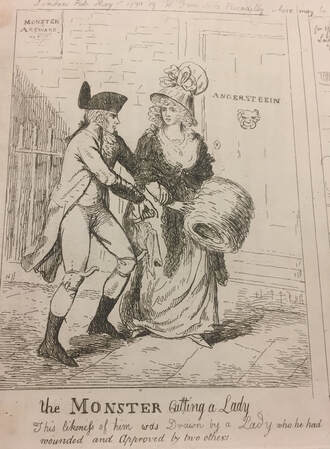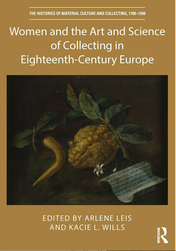 “The Monster Cutting a Lady,” May 1790, Robert Isaac Cruikshank, Collection of British Prints, The Huntington Library.
“The Monster Cutting a Lady,” May 1790, Robert Isaac Cruikshank, Collection of British Prints, The Huntington Library.
My research is dedicated to examining the relationship of print culture to gender and imperial whiteness in the late eighteenth century and Romantic period. Importantly, my project takes two forms: 1) a monograph entitled, The Pacific , Romanticism, and the British Colonial Print Matrix: Critiquing Imperial Whiteness through Women’s Ephemera Collections, Literature, and Print Illustration, and 2) a series of planned open-access digital exhibits (housed at sarahsophiabanks.com). While the monograph will appeal to readers in eighteenth-century studies, Romantic studies, and empire and print culture studies, the open- access digital exhibits will be designed for a broader, public audience interested in women’s history, collecting, and the history of the British empire.
My project situates the attacks of the infamous London Monster amid the colonial print matrix emerging around eighteenth-century Pacific exploration. Between 1788 and 1790, The Monster preyed on white women throughout London, cornering them in the dark, making lewd and sexually “obscene” comments, and poking them (often in the bottom) with a long, sharp pin. The convoluted nature of The Monster’s eventual capture and conviction exposes gaps in criminal definitions of sexual assault. While the violations are not generally connected in current scholarship, I contend that these gaps reveal modes of thinking about female sexuality that served to justify the rape and exploitation of Indigenous women in the Pacific during this period.
Through book chapters and digital exhibits, I complement and expand current work in eighteenth- century and Romantic studies by demonstrating the cultural process through which Indigenous persons and women were mediated to conform to imperial aims in print collections and the bound book. I interrogate how the accounts of The Monster's attacks in the period following the Cook voyages (1768- 1780) and documented in the scrapbook of collector Sarah Sophia Banks (1744-1818) further impact perceptions of agency, purity and whiteness among Indigenous populations. The depiction of the “fair” and pure women attacked by The Monster (THE NEW LADY’S MAGAZINE, July, 1790) and the resounding shock at such attacks on white women in England reveal racialized assumptions about purity that shape the depiction of the rape and exploitation of Indigenous women and of Polynesian culture in the print matrices of the late eighteenth century and the Romantic period.
While my research acknowledges that African and Native American Women were also the victims of such sexualization and exploitation, I am specifically focusing on Indigenous women in the Pacific in this project. I make these women my focus because the violations against them occurred alongside the presentation of Polynesia in popular print as a Garden of Eden, a place free of sexual inhibition, whose customs encouraged sexuality without shame. The circulation of these ideas about Polynesian culture and gender affects key elements of Romantic thought and culture, including, the fanciful imagination, escapism, sensuality, narrative, and the sublime. Major influences on these perceptions of Indigenous women include John Hawkesworth, who, in his official account of James Cook’s voyages to the Pacific (1773), used Christian symbolism to code Polynesian women’s sexual violation as part of “ceremony.” Sarah Sophia Banks and her collections also offer significant links connecting The Monster, print culture, women’s narratives, and the imperial ambitions and exploitations of the Banks family.
To understand the racism and white supremacy inherent in the British colonial print matrix, we must not only look beyond canonical literary works; we must also find ways to disseminate scholarship beyond the page and beyond the academic monograph. My project demonstrates, pairing the monograph with open-access digital exhibits, how the narratives of female flight found in the hot air balloon scrapbooks of Sarah Sophia Banks and other women in the nineteenth century lay a foundation not only for how these narratives offer alternative perspectives on the sweeping beliefs about Enlightenment progress, but also how they code the narrative of female agency as inherently white. The completion of this project will significantly affect how eighteenth-century and Romantic scholars study the depiction of women and people of color across the colonial print matrix. Additionally, the public-focused articulation of the research online via sarahsophiabanks.com will continue important work in the digital and public humanities, displaying collections of materials that would otherwise be inaccessible to the public and exposing this significant moment in the history of women’s rights and colonialism. This portion of the project will appeal to a diverse audience beyond academia and is especially significant in our own historical moment, not only in regards to questions about women’s dress that too often follow accusations of sexual assault, but also in the ways that women of color are left out of conversations and moves for reform.
Relevant Publications and Awards

Books
Leis and Wills, ed's. Women and the Art and Science of Collecting in Eighteenth-Century Europe, Routledge, 2020.
https://www.routledge.com/Women-and-the-Art-and-Science-of-Collecting-in-Eighteenth-Century-Europe/Leis-Wills/p/book/9780367856663
Peer-Reviewed Articles
“’It is easy making a lie; the contradicting of which the next day will make another paragraph’: The Travels of Hildebrand Bowman and the Critique of the British Colonial Print Matrix,” English Studies, vol. 102, issue 1 (2021). https://doi.org/10.1080/0013838X.2020.1866310
Wills and Hayes. “Research Interrupted: A Reflection on Digitizing Sarah Sophia Banks’s Collections and Access to Ephemeral Materials,” Romanticism on the Net, issue 74-75 (Spring-Fall 2020). ronjournal.org/s/6420
Hayes and Wills. “Visualizing Sarah Sophia Banks’ African Coins,” co-author, Interdisciplinary Digital Engagement & Humanities, vol. 1, issue, 1 (2020). https://doi.org/10.21428/f1f23564.1d32a4b3
Book Chapters
Hayes and Wills. “Sarah Sophia Banks’s Coin Collection: Female Networks of Exchange,” Women and the Art and Science of Collecting in Eighteenth-Century Europe, Routledge, 2020, pp. 78-92.
“Visualising the Indigenous Pacific,” The Edinburgh Companion to Romanticism and the Arts, Edinburgh University Press, 2022.
https://edinburghuniversitypress.com/book-the-edinburgh-companion-to-romanticism-and-the-arts.html
Short Critical Work
“Romantic Fancy in the Context of Pacific Exploration,” The Keats-Shelley Journal, vol. 68 (2019). muse.jhu.edu/article/771186
Digital Projects
The Caribbean and Romanticism, online exhibit curated for the Keats-Shelley Association of America,
Spring 2023, https://www.k-saa.org/caribbeanandromanticism
Exploring the Collections of Sarah Sophia Banks, created with Erica Hayes, MLS, MIS,
sarahsophiabanks.com
Blogs
"The Monster and Sarah Sophia Banks's Ephemera Collection: Sexual Violence in Print Media," The Keats-Shelley Association of America Uncovering the Archives Blog, www.k-saa.org/blog/sample-7n5ne-tmm6j-xr5ea-xxcm3-pt867-xchfr-xfs68?rq=wills
Presentations
“Constructions of Identity and Intimacy through Print Illustration and the Commonplace Book,” The Keats House, London. June, 2023.
Wills and Hayes. “Sexual Assault, The London Monster, and the Media’s Narratives of Seduction." ASECS. St. Louis, March, 2023.
“(Re)mediating Sensational Experience: Ballooning ephemera, Scrapbooking, and the Digital Space." North American Society for the Study of Romanticism/British Association for Romantic Study. Liverpool/Virtual, August, 2022.
Awards
I am the recent recipient of a Keats-Shelley Association of America Carl H. Pforzheimer, Jr. Research Grant (2019) and a Huntington Library Short-Term Dibner Fellowship in the History of Science (2021).